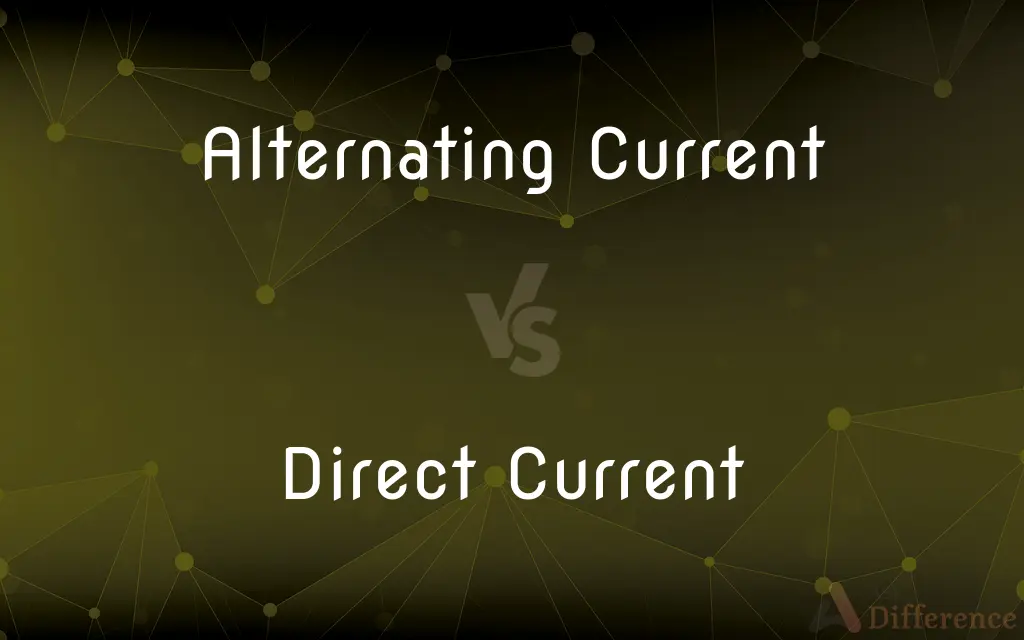Alternating Current vs. Direct Current — What's the Difference?
By Tayyaba Rehman — Published on February 12, 2024
Alternating Current (AC) flows in cycles, changing direction, while Direct Current (DC) flows steadily in one direction. AC is common in households, DC in batteries and electronics.

Difference Between Alternating Current and Direct Current
Table of Contents
ADVERTISEMENT
Key Differences
Alternating Current (AC) describes the flow of electric charge that periodically reverses direction. In AC systems, the voltage alternates in a sinusoidal manner, creating cycles. AC is widely used for power distribution in homes and businesses due to its efficient transmission over long distances.
Direct Current (DC) involves a continuous flow of electric charge in a single direction. Unlike AC, DC maintains a constant voltage level. DC is commonly found in batteries, electronic devices, and small-scale power applications. It is known for providing a stable and reliable power source.
Comparison Chart
Flow Direction
Periodically reverses direction
Flows steadily in one direction
Voltage Characteristics
Alternates in a sinusoidal manner
Maintains a constant voltage level
Common Applications
Power distribution in households
Batteries, electronic devices
ADVERTISEMENT
Transmission Efficiency
Efficient over long distances
Suitable for short-distance transmission
Power Source
Grid power in homes and businesses
Common in batteries and small electronics
Compare with Definitions
Alternating Current
Alternating Current flows in cycles.
Alternating Current completes one full cycle when it changes direction from positive to negative and back.
Direct Current
Direct Current flows steadily in one direction.
Direct Current provides a constant and unidirectional flow of electric charge.
Alternating Current
AC voltage alternates in a sinusoidal manner.
The sinusoidal wave of Alternating Current ensures smooth and efficient power transmission.
Direct Current
DC can be converted to AC with inverters.
Inverters convert Direct Current from solar panels or batteries into Alternating Current for use in homes.
Alternating Current
AC frequency determines the number of cycles per second.
The frequency of Alternating Current in most power systems is 60 hertz, completing 60 cycles per second.
Direct Current
DC is commonly found in batteries.
Batteries, such as those in electronic devices, generate Direct Current for consistent power supply.
Alternating Current
AC is ideal for transformer-based systems.
Transformers efficiently operate with Alternating Current, enabling voltage adjustment and distribution.
Direct Current
DC powers electronic devices.
Most electronic devices, like smartphones and laptops, operate on Direct Current.
Alternating Current
AC is commonly used for power distribution.
Alternating Current is the standard for power distribution in households and commercial buildings.
Direct Current
DC maintains a constant voltage level.
The stability of Direct Current voltage is crucial for reliable and continuous power in electronic applications.
Common Curiosities
How does AC voltage vary?
AC voltage alternates in a sinusoidal manner, completing cycles from positive to negative and back.
What are common applications of AC?
AC is commonly used for power distribution in households, businesses, and industries.
What is Direct Current (DC)?
Direct Current involves a continuous flow of electric charge in a single direction, commonly found in batteries and electronics.
Why is DC known for stability?
DC maintains a constant voltage level, providing stable and reliable power for electronic applications.
What is the frequency of AC in power systems?
The frequency of AC in most power systems is 60 hertz, completing 60 cycles per second.
How is AC transmitted over long distances?
AC is efficient for long-distance transmission, reducing energy losses, and enabling power distribution across grids.
Where is DC commonly found?
DC is commonly found in batteries, powering devices such as smartphones, laptops, and flashlights.
What is the role of transformers in AC systems?
Transformers operate efficiently with AC, allowing voltage adjustment and facilitating power distribution.
What is Alternating Current (AC)?
Alternating Current is the flow of electric charge that periodically reverses direction, commonly used for power distribution.
Is DC used in power grids?
DC is less common in power grids but may be used for specific applications, such as high-voltage transmission.
Can AC be converted to DC?
Yes, AC can be converted to DC using devices like rectifiers, commonly used in power supply units.
Why is AC ideal for power distribution?
AC is ideal for power distribution due to its efficiency in transmitting electricity over long distances.
Can DC power be generated from renewable sources?
Yes, DC power is often generated from renewable sources like solar panels and wind turbines.
How does DC contribute to portable power?
DC from batteries contributes to portable power sources, enabling the operation of various electronic devices.
What is the role of inverters in DC systems?
Inverters convert DC from sources like solar panels or batteries into AC, making it compatible with standard household appliances.
Share Your Discovery

Previous Comparison
Joe Frazier vs. Muhammad Ali
Next Comparison
Glock vs. M1911Author Spotlight
Written by
Tayyaba RehmanTayyaba Rehman is a distinguished writer, currently serving as a primary contributor to askdifference.com. As a researcher in semantics and etymology, Tayyaba's passion for the complexity of languages and their distinctions has found a perfect home on the platform. Tayyaba delves into the intricacies of language, distinguishing between commonly confused words and phrases, thereby providing clarity for readers worldwide.
















































